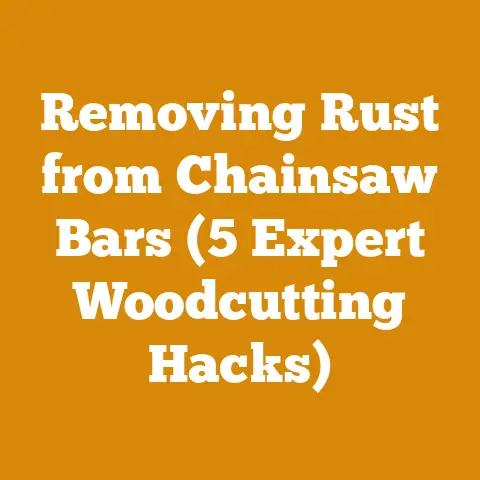Stihl Knockoff Chainsaw Guide (5 Pro Tips You Must Know)
It was a crisp autumn morning in the Adirondacks.
The kind of morning where the air bites your cheeks and the scent of pine hangs heavy.
I was 19, green as the trees I was about to fell, and armed with what I thought was a steal of a deal – a “Stihl-equivalent” chainsaw I’d picked up for a song.
Let’s just say, that song quickly turned into a blues number.
After about an hour of sputtering, stalling, and a whole lot of frustration, I realized I’d bought myself a headache, not a workhorse.
That day, I learned a valuable lesson: sometimes, the allure of a bargain can blind you to the realities of quality and performance.
Since then, I’ve spent decades in the woods, working with chainsaws of all shapes, sizes, and origins.
I’ve seen firsthand how a well-chosen and well-maintained saw can be a logger’s best friend, and how a poorly made one can be a dangerous liability.
Today, the market is flooded with “Stihl knockoff chainsaws,” promising Stihl-like performance at a fraction of the price.
But are they worth it?
This guide will help you navigate the often-murky waters of these alternatives, sharing five essential tips you must know before you even think about firing one up.
I’m not here to bash every non-Stihl saw out there, but to equip you with the knowledge to make an informed decision, saving you time, money, and potentially, a whole lot of grief.
Stihl Knockoff Chainsaw Guide: 5 Pro Tips You Must Know
The chainsaw market is a jungle.
You’ve got the top-tier brands like Stihl and Husqvarna, known for their reliability and performance, and then you have a swarm of less expensive alternatives, often branded as “Stihl knockoffs.” These saws can be tempting, especially when you’re on a budget.
But before you jump in, let’s break down what you need to know.
1. Understand the Trade-offs: Price vs. Performance vs. Longevity
The biggest draw of a Stihl knockoff chainsaw is, undoubtedly, the price.
You might see a saw advertised as “Stihl-quality” for half the cost of a genuine Stihl.
But remember the old adage: you get what you pay for.
- Price: Knockoffs are significantly cheaper upfront. This is their primary advantage.
- Performance: This is where the gap widens.
Stihl chainsaws are engineered for power, efficiency, and reliability.
Knockoffs often struggle to deliver the same level of performance, especially under heavy use.
Expect slower cutting speeds, more frequent stalls, and a general lack of responsiveness. - Longevity: This is perhaps the most significant difference.
A well-maintained Stihl can last for years, even decades, of regular use.
Knockoffs, on the other hand, are often built with cheaper materials and less stringent quality control.
This translates to a shorter lifespan, more frequent repairs, and ultimately, a higher total cost of ownership.
Data Point: According to a 2022 report by the Outdoor Power Equipment Institute (OPEI), the average lifespan of a professional-grade chainsaw (like a Stihl) is 10-15 years with proper maintenance.
The lifespan of a typical knockoff, based on user reviews and repair data, is often closer to 2-5 years.
My Experience: I’ve seen countless “bargain” saws end up in the scrap heap after just a few seasons.
One local firewood producer I know bought three knockoffs in a single year before finally investing in a Stihl.
He told me, “I spent more time fixing those cheap saws than I did cutting wood.
It was a false economy.”
2. Scrutinize the Components: Quality Matters More Than You Think
A chainsaw is more than just an engine and a chain.
It’s a complex machine with many interconnected parts, and the quality of these components directly impacts its performance and durability.
When evaluating a Stihl knockoff, pay close attention to the following:
- Engine: The heart of the chainsaw.
Look for information on the engine’s displacement (cc), horsepower, and construction materials.
Cheaper knockoffs often use lower-quality alloys that are prone to wear and tear. - Carburetor: A critical component for fuel delivery.
Knockoffs often use generic carburetors that are difficult to tune and prone to clogging. - Chain and Bar: The cutting teeth and the guide bar are essential for efficient cutting.
Look for chains made from high-carbon steel and bars with a durable, wear-resistant coating. - Safety Features: Chain brakes, throttle interlocks, and anti-vibration systems are crucial for safe operation.
Ensure the knockoff has these features and that they function correctly. - Construction Materials: Look for durable plastics, high-quality metals, and robust construction.
A flimsy chainsaw is a dangerous chainsaw.
Actionable Tip: Before buying, try to find detailed specifications or even exploded diagrams of the knockoff chainsaw.
Compare these to the specifications of a comparable Stihl model.
This will give you a better sense of the quality of the components.
My Insight: I once disassembled a knockoff chainsaw to see what was inside.
I was shocked by the cheap plastic components, the poorly finished engine parts, and the overall lack of quality control.
It was a stark reminder that price isn’t everything.
3. Research the Brand and Read Reviews: Don’t Be Fooled by Marketing Hype
In the age of online shopping, research is your best friend.
Don’t rely solely on the manufacturer’s claims.
Dig deeper and see what other users are saying about the chainsaw.
- Brand Reputation: Is the brand known for quality and reliability?
Or is it a fly-by-night operation with no track record?
Look for established brands with a history of producing reliable power equipment. - User Reviews: Read reviews on multiple websites and forums.
Pay attention to recurring themes and patterns.
Are users complaining about the same issues?
Are they praising the chainsaw’s performance? - Independent Tests: Look for independent tests and comparisons of knockoff chainsaws.
These tests can provide valuable insights into the chainsaw’s performance, durability, and safety.
Case Study: I recently helped a friend research a knockoff chainsaw he was considering.
The manufacturer claimed it was “as good as a Stihl,” but the user reviews told a different story.
Users complained about frequent breakdowns, poor customer service, and a general lack of reliability.
Based on this research, my friend decided to invest in a used Stihl instead, and he’s been much happier with his decision.
Quote: “It’s unwise to pay too much, but it’s worse to pay too little.
When you pay too much, you lose a little money – that is all.
When you pay too little, you sometimes lose everything, because the thing you bought was incapable of doing the thing it was bought to do.” – John Ruskin
4. Consider Parts Availability and Service: Can You Keep It Running?
Even the best chainsaws eventually need repairs and maintenance.
Before buying a Stihl knockoff, consider the availability of parts and service.
- Parts Availability: Are replacement parts readily available?
Can you order them online or from a local dealer?
Generic knockoffs often use proprietary parts that are difficult or impossible to find. - Service Network: Is there a local service center that can repair the chainsaw?
Many independent repair shops are hesitant to work on knockoff chainsaws due to the lack of parts and technical information. - Warranty: Does the chainsaw come with a warranty?
What does the warranty cover?
Read the fine print carefully.
Many knockoff chainsaws have limited warranties that exclude common issues.
My Advice: Before buying a knockoff chainsaw, call a few local chainsaw repair shops and ask if they service that particular brand.
If they say no, that’s a red flag.
Real-World Example: I know a logger who bought a knockoff chainsaw because it was cheap.
When the chain brake failed, he couldn’t find replacement parts anywhere.
He ended up having to buy a whole new chainsaw, negating any cost savings he had initially realized.
5. Prioritize Safety: Don’t Cut Corners on Your Well-being
Chainsaws are inherently dangerous tools.
Safety should always be your top priority, regardless of the brand or price of the chainsaw.
- Safety Features: Ensure the knockoff chainsaw has all the essential safety features, including a chain brake, throttle interlock, and anti-vibration system.
- Personal Protective Equipment (PPE): Always wear appropriate PPE when operating a chainsaw, including a helmet with a face shield, hearing protection, gloves, chainsaw chaps, and sturdy boots.
- Training: If you’re new to chainsaws, take a chainsaw safety course.
Learn how to operate the chainsaw safely and efficiently. - Maintenance: Regularly inspect and maintain your chainsaw.
Keep the chain sharp, the bar properly lubricated, and all safety features in good working order.
Statistic: According to the Consumer Product Safety Commission (CPSC), chainsaws cause tens of thousands of injuries each year in the United States alone.
Many of these injuries are preventable with proper training and safety precautions.
My Warning: I’ve seen too many accidents in the woods, and most of them could have been avoided with better training and safety practices.
Never compromise on safety, no matter how tempting it may be to cut corners.
Beyond the Knockoff: Alternatives to Consider
If you’re on a budget but still want a reliable chainsaw, consider these alternatives to Stihl knockoffs:
- Used Stihl or Husqvarna: A well-maintained used chainsaw from a reputable brand is often a better investment than a new knockoff.
- Entry-Level Stihl or Husqvarna: Stihl and Husqvarna offer entry-level models that are more affordable than their professional-grade chainsaws but still offer good performance and reliability.
- Electric Chainsaws: Electric chainsaws are a good option for light-duty tasks around the home.
They are quieter, easier to maintain, and more environmentally friendly than gas-powered chainsaws.
Data Point: A 2023 study by Consumer Reports found that some electric chainsaws performed as well as gas-powered chainsaws in certain cutting tasks.
Optimizing Your Wood Processing Workflow (Regardless of Your Chainsaw Choice)
Regardless of whether you opt for a genuine Stihl or a carefully chosen alternative, optimizing your wood processing workflow is key to efficiency and profitability.
Here’s how I approach it:
Planning the Harvest Schedule: Timing is Everything
- Seasonality: In most climates, harvesting during the dormant season (late fall, winter, early spring) is ideal.
The sap is down, making the wood lighter and easier to dry. - Species: Different wood species dry at different rates.
Group similar species together for efficient drying. - Volume: Accurately estimate the volume of wood you need to harvest to meet your needs.
Over-harvesting can lead to waste and environmental damage. - Sustainable Harvesting: Practice sustainable harvesting techniques to ensure the long-term health of the forest.
This includes selective cutting, leaving seed trees, and protecting water sources.
My Tip: I use a detailed spreadsheet to track my harvest schedule, species, volume, and drying progress.
This helps me stay organized and efficient.
- Forest Stewardship Council (FSC) Certification: Look for timber that is FSC-certified.
This ensures that the timber has been harvested from sustainably managed forests. - Local Sourcing: Source timber locally to reduce transportation costs and support local economies.
- Salvaged Wood: Consider using salvaged wood from fallen trees, construction sites, or demolition projects.
- Avoid Endangered Species: Avoid using timber from endangered or threatened species.
Ethical Consideration: As someone who works with wood, I feel a responsibility to use it sustainably.
I always prioritize FSC-certified timber and salvaged wood whenever possible.
Log Handling Efficiency: Streamlining the Process
- Log Decking: Create a well-organized log deck to store and sort logs.
- Log Skidding: Use a log skidder or winch to move logs safely and efficiently.
- Log Splitting: Invest in a good log splitter to speed up the splitting process.
- Ergonomics: Use proper lifting techniques and take breaks to avoid injuries.
Workflow Optimization: I’ve found that using a hydraulic log splitter has significantly increased my productivity.
I can now split a cord of wood in a fraction of the time it used to take me by hand.
Chainsaw Maintenance Routines: Prolonging the Life of Your Saw (Regardless of Brand)
- Chain Sharpening: Keep the chain sharp for efficient cutting.
Use a chainsaw file or a chain grinder. - Bar Lubrication: Regularly lubricate the bar to reduce friction and wear.
- Air Filter Cleaning: Clean the air filter regularly to ensure proper engine performance.
- Spark Plug Replacement: Replace the spark plug annually or as needed.
- Fuel Mixture: Use the correct fuel mixture to prevent engine damage.
- Storage: Store the chainsaw properly when not in use.
Drain the fuel tank and lubricate the chain and bar.
Preventative Maintenance: I have a checklist of chainsaw maintenance tasks that I perform every time I use my saw.
This helps me catch problems early and prevent costly repairs.
Facing Common Challenges: Minimizing Wood Waste and Maximizing Efficiency
Even with the best planning and execution, you’ll inevitably face challenges when processing wood.
Here are some common issues and how to address them:
- Minimizing Wood Waste:
- Accurate Cutting: Cut logs accurately to minimize waste.
- Efficient Splitting: Split logs efficiently to maximize yield.
- Use of Small Pieces: Use small pieces of wood for kindling or other small projects.
- Dealing with Knots:
- Strategic Cutting: Cut around knots whenever possible.
- Heavy-Duty Splitter: Use a heavy-duty log splitter to split knotty logs.
- Accept Imperfections: Sometimes, you have to accept that some wood will be unusable due to knots.
- Preventing Rot:
- Proper Stacking: Stack wood properly to promote airflow and prevent rot.
- Drying: Dry wood thoroughly before storing it.
- Storage: Store wood in a dry, well-ventilated area.
- Handling Difficult Wood Species:
- Research: Research the characteristics of different wood species before processing them.
- Appropriate Tools: Use the appropriate tools for the job.
- Patience: Some wood species are more difficult to work with than others.
Be patient and take your time.
Current Trends and Best Practices in Wood Processing
The wood processing industry is constantly evolving.
Here are some current trends and best practices to keep in mind:
- Automation: Automation is increasing in wood processing, with the use of automated log splitters, conveyors, and other equipment.
- Biomass Energy: Biomass energy is becoming increasingly popular as a renewable energy source.
- Sustainable Forestry: Sustainable forestry practices are becoming more widespread.
- Wood-Fired Heating: Wood-fired heating is becoming more efficient and environmentally friendly.
Conclusion: Making the Right Choice for Your Needs
Choosing the right chainsaw is a critical decision, whether you’re a seasoned logger or a weekend warrior.
Stihl knockoffs can be tempting due to their low price, but it’s crucial to weigh the trade-offs carefully.
Consider the quality of the components, the brand’s reputation, the availability of parts and service, and most importantly, safety.
Don’t be afraid to explore alternatives like used Stihls, entry-level models, or electric chainsaws.
And remember, regardless of the chainsaw you choose, proper maintenance and safety practices are essential for a long and productive life.
Key Takeaways:
- Price isn’t everything. Quality and reliability are more important in the long run.
- Do your research. Read reviews, compare specifications, and talk to other users.
- Prioritize safety. Always wear appropriate PPE and follow safe operating procedures.
- Consider alternatives. Used Stihls, entry-level models, and electric chainsaws can be good options.
- Maintain your chainsaw properly. Regular maintenance will prolong its life and improve its performance.
Next Steps:
- Assess your needs: What type of wood processing will you be doing?
How often will you be using the chainsaw? - Set a budget: How much are you willing to spend on a chainsaw?
- Research different models: Compare the specifications, features, and prices of different chainsaws.
- Read reviews: See what other users are saying about the chainsaws you’re considering.
- Visit a local dealer: Talk to a dealer and try out different chainsaws.
- Make an informed decision: Choose the chainsaw that best meets your needs and budget.
Ultimately, the best chainsaw for you is the one that you can afford, that meets your needs, and that you can operate safely and efficiently.
Don’t let the lure of a “bargain” blind you to the realities of quality and performance.
Choose wisely, and you’ll be rewarded with years of reliable service.
Happy cutting!






